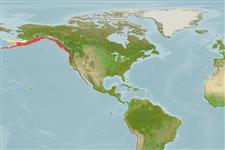Common names from other countries
Classification / Names / Names
Namen | Synonyme | Catalog of Fishes (gen., sp.) | ITIS | CoL | WoRMS
Environment: milieu / climate zone / depth range / distribution range
Ökologie
; tiefenbereich 2 - 300 m (Ref. 114301), usually 60 - 120 m (Ref. 114306). Temperate, preferred 7°C (Ref. 107945); 64°N - 36°N, 179°W - 120°W
Eastern Pacific: From Pribilof Islands, Alaska to Point Sur, California, USA. Temperate to boreal.
Length at first maturity / Size / Gewicht / Alter
Maturity: Lm ? range ? - ? cm Max length : 28.0 cm SHL Männchen/unbestimmt; (Ref. 95344); max. veröff. Alter: 15 Jahre (Ref. 8702)
Found in small depressions on sandy-gravely substrates (Ref. 95344).
Life cycle and mating behavior
Geschlechtsreife | Fortpflanzung | Ablaichen | Eier | Fecundity | Larven
Members of the class Bivalvia are mostly gonochoric, some are protandric hermaphrodites. Life cycle: Embryos develop into free-swimming trocophore larvae, succeeded by the bivalve veliger, resembling a miniature clam.
Ignell, S. and E. Haynes. 2000. (Ref. 386)
IUCN Rote Liste Status (Ref. 130435)
CITES Status (Ref. 108899)
Not Evaluated
Not Evaluated
Nutzung durch Menschen
Fischereien: kommerziell
FAO - Fischereien: landings | FishSource | Sea Around Us
Tools
Internet Quellen
Estimates based on models
Preferred temperature
(Ref.
115969): 0.7 - 9.6, mean 5.1 (based on 348 cells).
Widerstandsfähigkeit
hoch, Verdopplung der Population dauert weniger als 15 Monate. (K=0.39-0.5; tmax=15).
Verwundbarkeit
Low to moderate vulnerability (32 of 100).
